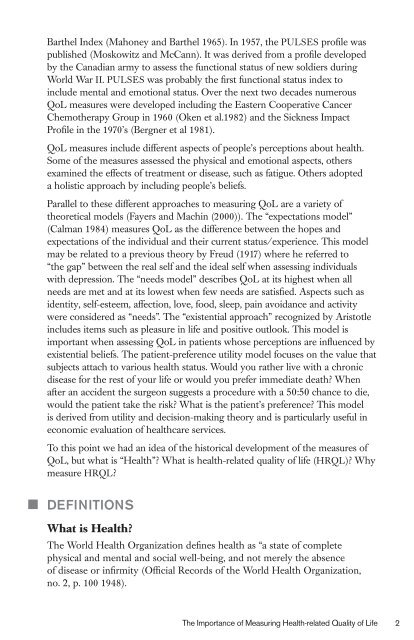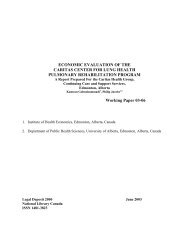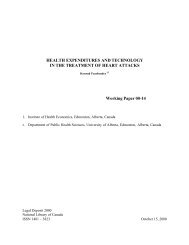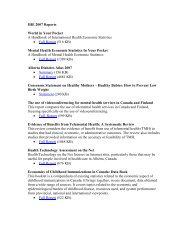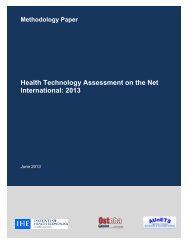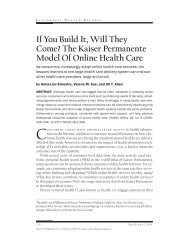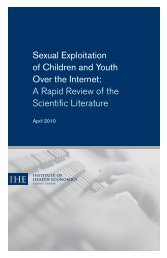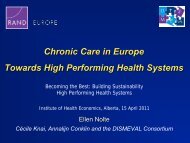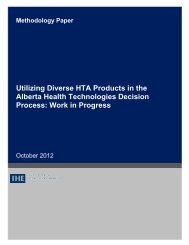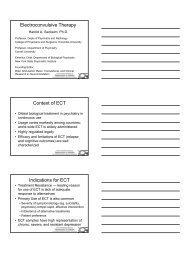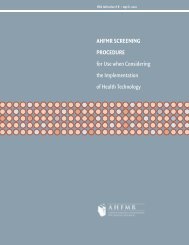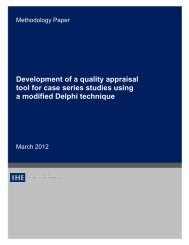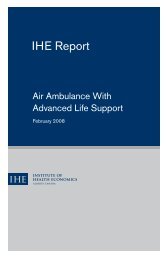IHE Report - Institute of Health Economics
IHE Report - Institute of Health Economics
IHE Report - Institute of Health Economics
- No tags were found...
Create successful ePaper yourself
Turn your PDF publications into a flip-book with our unique Google optimized e-Paper software.
Barthel Index (Mahoney and Barthel 1965). In 1957, the PULSES pr<strong>of</strong>ile waspublished (Moskowitz and McCann). It was derived from a pr<strong>of</strong>ile developedby the Canadian army to assess the functional status <strong>of</strong> new soldiers duringWorld War II. PULSES was probably the first functional status index toinclude mental and emotional status. Over the next two decades numerousQoL measures were developed including the Eastern Cooperative CancerChemotherapy Group in 1960 (Oken et al.1982) and the Sickness ImpactPr<strong>of</strong>ile in the 1970’s (Bergner et al 1981).QoL measures include different aspects <strong>of</strong> people’s perceptions about health.Some <strong>of</strong> the measures assessed the physical and emotional aspects, othersexamined the effects <strong>of</strong> treatment or disease, such as fatigue. Others adopteda holistic approach by including people’s beliefs.Parallel to these different approaches to measuring QoL are a variety <strong>of</strong>theoretical models (Fayers and Machin (2000)). The “expectations model”(Calman 1984) measures QoL as the difference between the hopes andexpectations <strong>of</strong> the individual and their current status/experience. This modelmay be related to a previous theory by Freud (1917) where he referred to“the gap” between the real self and the ideal self when assessing individualswith depression. The “needs model” describes QoL at its highest when allneeds are met and at its lowest when few needs are satisfied. Aspects such asidentity, self-esteem, affection, love, food, sleep, pain avoidance and activitywere considered as “needs”. The “existential approach” recognized by Aristotleincludes items such as pleasure in life and positive outlook. This model isimportant when assessing QoL in patients whose perceptions are influenced byexistential beliefs. The patient-preference utility model focuses on the value thatsubjects attach to various health status. Would you rather live with a chronicdisease for the rest <strong>of</strong> your life or would you prefer immediate death? Whenafter an accident the surgeon suggests a procedure with a 50:50 chance to die,would the patient take the risk? What is the patient’s preference? This modelis derived from utility and decision-making theory and is particularly useful ineconomic evaluation <strong>of</strong> healthcare services.To this point we had an idea <strong>of</strong> the historical development <strong>of</strong> the measures <strong>of</strong>QoL, but what is “<strong>Health</strong>”? What is health-related quality <strong>of</strong> life (HRQL)? Whymeasure HRQL?DEFINITIONSWhat is <strong>Health</strong>?The World <strong>Health</strong> Organization defines health as “a state <strong>of</strong> completephysical and mental and social well-being, and not merely the absence<strong>of</strong> disease or infirmity (Official Records <strong>of</strong> the World <strong>Health</strong> Organization,no. 2, p. 100 1948).The Importance <strong>of</strong> Measuring <strong>Health</strong>-related Quality <strong>of</strong> Life 2


